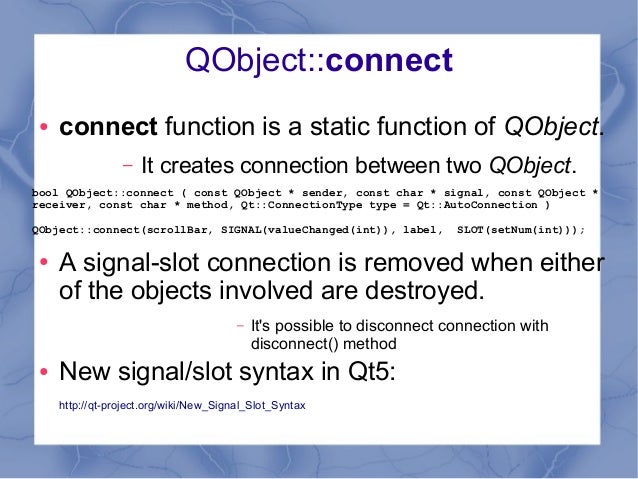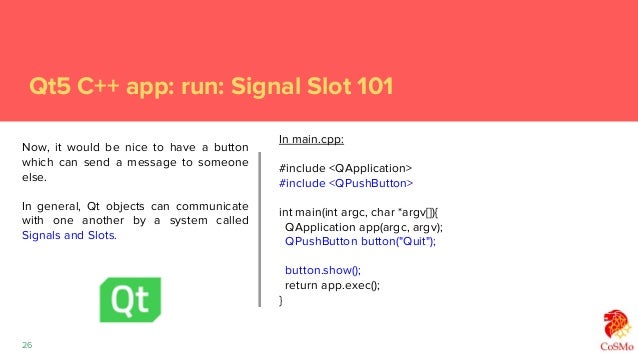Qt5 Slots
Build complex application behaviours using signals and slots, and override widget event handling with custom events.
As already described, every interaction the user has with a Qt application causes an Event. There are multiple types of event, each representing a difference type of interaction — e.g. mouse or keyboard events.
The slot function can be any member function that can be connected to the signal. A slot can be connected to a given signal if the signal has at least as many arguments as the slot, and there is an implicit conversion between the types of the corresponding arguments in the signal and the slot. Signals and slots are used for communication between objects. The signals and slots mechanism is a central feature of Qt. In GUI programming, when we change one widget, we often want another widget to be notified. More generally, we want objects of any kind to be able to communicate with one another. Casino.org Qt5 Signals And Slots is the world’s leading independent online gaming authority, providing trusted online casino news, guides, reviews and information since 1995. Qt5 Slots And Signals legal age to gamble in a Know When to Stop Before You Start®. Call 1-800-522-4700.
Events that occur are passed to the event-specific handler on the widget where the interaction occurred. For example, clicking on a widget will cause a QMouseEvent to be sent to the .mousePressEvent event handler on the widget. This handler can interrogate the event to find out information, such as what triggered the event and where specifically it occurred.
You can intercept events by subclassing and overriding the handler function on the class, as you would for any other function. You can choose to filter, modify, or ignore events, passing them through to the normal handler for the event by calling the parent class function with super().
However, imagine you want to catch an event on 20 different buttons. Subclassing like this now becomes an incredibly tedious way of catching, interpreting and handling these events.
While being better in many regards, the new connection syntax in Qt5 has one big weakness: Connecting overloaded signals and slots. In order to let the compiler resolve the overloads we need to use staticcast s to member function pointers, or (starting in Qt 5.7) qOverload and friends.
Thankfully Qt offers a neater approach to receiving notification of things happening in your application: Signals.
Signals
Instead of intercepting raw events, signals allow you to 'listen' for notifications of specific occurrences within your application. While these can be similar to events — a click on a button — they can also be more nuanced — updated text in a box. Data can also be sent alongside a signal - so as well as being notified of the updated text you can also receive it.
The receivers of signals are called Slots in Qt terminology. A number of standard slots are provided on Qt classes to allow you to wire together different parts of your application. However, you can also use any Python function as a slot, and therefore receive the message yourself.
Load up a fresh copy of `MyApp_window.py` and save it under a new name for this section. The code is copied below if you don't have it yet.
Basic signals
First, let's look at the signals available for our QMainWindow. You can find this information in the Qt documentation. Scroll down to the Signals section to see the signals implemented for this class.
Qt 5 Documentation — QMainWindow Signals
As you can see, alongside the two QMainWindow signals, there are 4 signals inherited from QWidget and 2 signals inherited from Object. If you click through to the QWidget signal documentation you can see a .windowTitleChanged signal implemented here. Next we'll demonstrate that signal within our application.
Qt 5 Documentation — Widget Signals
The code below gives a few examples of using the windowTitleChanged signal.
Try commenting out the different signals and seeing the effect on what the slot prints.
We start by creating a function that will behave as a ‘slot’ for our signals.

Then we use .connect on the .windowTitleChanged signal. We pass the function that we want to be called with the signal data. In this case the signal sends a string, containing the new window title.
If we run that, we see that we receive the notification that the window title has changed.
Events
Next, let’s take a quick look at events. Thanks to signals, for most purposes you can happily avoid using events in Qt, but it’s important to understand how they work for when they are necessary.
As an example, we're going to intercept the .contextMenuEvent on QMainWindow. This event is fired whenever a context menu is about to be shown, and is passed a single value event of type QContextMenuEvent.
To intercept the event, we simply override the object method with our new method of the same name. So in this case we can create a method on our MainWindow subclass with the name contextMenuEvent and it will receive all events of this type.
If you add the above method to your MainWindow class and run your program you will discover that right-clicking in your window now displays the message in the print statement.

Sometimes you may wish to intercept an event, yet still trigger the default (parent) event handler. You can do this by calling the event handler on the parent class using super as normal for Python class methods.
This allows you to propagate events up the object hierarchy, handling only those parts of an event handler that you wish.
However, in Qt there is another type of event hierarchy, constructed around the UI relationships. Widgets that are added to a layout, within another widget, may opt to pass their events to their UI parent. In complex widgets with multiple sub-elements this can allow for delegation of event handling to the containing widget for certain events.
However, if you have dealt with an event and do not want it to propagate in this way you can flag this by calling .accept() on the event.
Alternatively, if you do want it to propagate calling .ignore() will achieve this.
In this section we've covered signals, slots and events. We've demonstratedsome simple signals, including how to pass less and more data using lambdas.We've created custom signals, and shown how to intercept events, pass onevent handling and use .accept() and .ignore() to hide/show eventsto the UI-parent widget. In the next section we will go on to takea look at two common features of the GUI — toolbars and menus.
Signals and slots are used for communication between objects. The signals and slots mechanism is a central feature of Qt and probably the part that differs most from the features provided by other frameworks. Signals and slots are made possible by Qt's meta-object system .
Introduction
In GUI programming, when we change one widget, we often want another widget to be notified. More generally, we want objects of any kind to be able to communicate with one another. For example, if a user clicks a Close button, we probably want the window's close() function to be called.
Other toolkits achieve this kind of communication using callbacks. A callback is a pointer to a function, so if you want a processing function to notify you about some event you pass a pointer to another function (the callback) to the processing function. The processing function then calls the callback when appropriate. While successful frameworks using this method do exist, callbacks can be unintuitive and may suffer from problems in ensuring the type-correctness of callback arguments.
Signals and Slots
In Qt, we have an alternative to the callback technique: We use signals and slots. A signal is emitted when a particular event occurs. Qt's widgets have many predefined signals, but we can always subclass widgets to add our own signals to them. A slot is a function that is called in response to a particular signal. Qt's widgets have many pre-defined slots, but it is common practice to subclass widgets and add your own slots so that you can handle the signals that you are interested in.
- Signals and slots in Qt
The signals and slots mechanism is type safe: The signature of a signal must match the signature of the receiving slot. (In fact a slot may have a shorter signature than the signal it receives because it can ignore extra arguments.) Since the signatures are compatible, the compiler can help us detect type mismatches when using the function pointer-based syntax. The string-based SIGNAL and SLOT syntax will detect type mismatches at runtime. Signals and slots are loosely coupled: A class which emits a signal neither knows nor cares which slots receive the signal. Qt's signals and slots mechanism ensures that if you connect a signal to a slot, the slot will be called with the signal's parameters at the right time. Signals and slots can take any number of arguments of any type. They are completely type safe.
All classes that inherit from QObject or one of its subclasses (e.g., QWidget ) can contain signals and slots. Signals are emitted by objects when they change their state in a way that may be interesting to other objects. This is all the object does to communicate. It does not know or care whether anything is receiving the signals it emits. This is true information encapsulation, and ensures that the object can be used as a software component.
Slots can be used for receiving signals, but they are also normal member functions. Just as an object does not know if anything receives its signals, a slot does not know if it has any signals connected to it. This ensures that truly independent components can be created with Qt.
You can connect as many signals as you want to a single slot, and a signal can be connected to as many slots as you need. It is even possible to connect a signal directly to another signal. (This will emit the second signal immediately whenever the first is emitted.)
Together, signals and slots make up a powerful component programming mechanism.
Signals
Signals are emitted by an object when its internal state has changed in some way that might be interesting to the object's client or owner. Signals are public access functions and can be emitted from anywhere, but we recommend to only emit them from the class that defines the signal and its subclasses.
When a signal is emitted, the slots connected to it are usually executed immediately, just like a normal function call. When this happens, the signals and slots mechanism is totally independent of any GUI event loop. Execution of the code following the emit statement will occur once all slots have returned. The situation is slightly different when using queued connections ; in such a case, the code following the emit keyword will continue immediately, and the slots will be executed later.
If several slots are connected to one signal, the slots will be executed one after the other, in the order they have been connected, when the signal is emitted.
Signals are automatically generated by the moc and must not be implemented in the .cpp file. They can never have return types (i.e. use void ).
A note about arguments: Our experience shows that signals and slots are more reusable if they do not use special types. If QScrollBar::valueChanged () were to use a special type such as the hypothetical QScrollBar::Range, it could only be connected to slots designed specifically for QScrollBar . Connecting different input widgets together would be impossible.
Slots
A slot is called when a signal connected to it is emitted. Slots are normal C++ functions and can be called normally; their only special feature is that signals can be connected to them.
Since slots are normal member functions, they follow the normal C++ rules when called directly. However, as slots, they can be invoked by any component, regardless of its access level, via a signal-slot connection. This means that a signal emitted from an instance of an arbitrary class can cause a private slot to be invoked in an instance of an unrelated class.
You can also define slots to be virtual, which we have found quite useful in practice.
Compared to callbacks, signals and slots are slightly slower because of the increased flexibility they provide, although the difference for real applications is insignificant. In general, emitting a signal that is connected to some slots, is approximately ten times slower than calling the receivers directly, with non-virtual function calls. This is the overhead required to locate the connection object, to safely iterate over all connections (i.e. checking that subsequent receivers have not been destroyed during the emission), and to marshall any parameters in a generic fashion. While ten non-virtual function calls may sound like a lot, it's much less overhead than any new or delete operation, for example. As soon as you perform a string, vector or list operation that behind the scene requires new or delete , the signals and slots overhead is only responsible for a very small proportion of the complete function call costs. The same is true whenever you do a system call in a slot; or indirectly call more than ten functions. The simplicity and flexibility of the signals and slots mechanism is well worth the overhead, which your users won't even notice.
Note that other libraries that define variables called signals or slots may cause compiler warnings and errors when compiled alongside a Qt-based application. To solve this problem, #undef the offending preprocessor symbol.
Connecting the signal to the slot
Prior to the fifth version of Qt to connect the signal to the slot through the recorded macros, whereas in the fifth version of the recording has been applied, based on the signs.
Writing with macros:

Writing on the basis of indicators:
The advantage of the second option is that it is possible to determine the mismatch of signatures and the wrong slot or signal name of another project compilation stage, not in the process of testing applications.

An example of using signals and slots
For example, the use of signals and slots project was created, which in the main window contains three buttons, each of which is connected to the slot and these slots already transmit a signal in a single slot with the pressed button number.
Project Structure
- Project Structure
According to the tradition of conducting lessons enclosing structure of the project, which is absolutely trivial and defaulted to the disgrace that will not even describe members of her classes and files.
mainwindow.h
Thus, the following three buttons - three slots, one signal at all three buttons, which is fed into the slot button and transmits the number buttons into a single slot that displays a message with the number buttons.
Qt5 Signals Slots Emit
mainwindow.cpp
Qt Slots Not Work
A file in this logic is configured as described in the preceding paragraphs. Just check the code and go to the video page, there is shown in detail the whole process, demonstrated the application, and also shows what happens if we make coding a variety of errors.